
You moved to England from Iran aged only two, do you strongly identify with the Iranian culture?
I feel that all of us, particularly people of ethnic minority backgrounds should be proud of who we are as people and as individuals first, and then where we come from. My beautiful and rich culture was translated to me through my parents, aunties, uncle’s, cousins and grandmother so I was very blessed in that sense.
Do you feel that your identification with your culture influences your work?
The culture that I was raised in was not one of a typical Iranian since I was raised in the Bahai Faith- a religion originating from Iran with one of its main principles being the unity of mankind and the elimination of all prejudices. The principles of this faith have deeply influenced the way in which I see the world and therefore influenced my work.
How did you find growing up in Britain?
As a child and young person I always felt like I didn’t fit in as I was always a minority in a predominantly white area. Also I was very much against the grain, even from a young age which didn’t help! But it has been a blessing to live in place where I have friends of many different cultures and walks of life-this broadens your mind and enriches your life-you wouldn’t have such opportunities in every city.
Do you feel that these life experiences have influenced your work?
I am both a photographic artist and a singer-songwriter and I would say in both cases my life experience informs my work. With regard to my imagery, my main, but not exclusive focus has been on people, from ethnic minority backgrounds (being one myself). People who have not necessarily been embraced by the mainstream world we live in.
At what age did you realise that you were a talented photographer?
I’ve been painting, drawing, singing and writing since I was a child but it was only in my early teens that after getting hold of a Pentax camera my love for photography started to grow. You could get amazing results fast and being someone who was always slow at everything it felt powerful!
What camera do you have?
I love Nikons but I’ll use most cameras as long as they work!
When you realised you wanted to do photography professionally, what was your first move?
I was blessed in the sense that I-D magazine picked up on my work at my degree show and after that many opportunities came my way and I tried to keep the momentum going, when opportunities arose, I made myself ready.

Use your camera for positive work, ask questions and reveal your truth about the world. Remain non-judgemental and non-competitive, and learn from everyone. Be bold in your approach and continually strive toward achieving your own level of excellence. I’d also say always be ready.
Why do you enjoy about taking pictures?
Because it allows me to speak with out having to use words.
How have you been able to exhibit your work in magazines such as I-D and Touch, and in venues such as Topshop, Oxford Circus and Selfridges, from London to New York?
Well firstly, to achieve all of these things has taken a lot of hard work, persistence and dedication. It really takes you getting out there in the world and showing people your work. I’d have to go in to a lot of detail as each opportunity mentioned was unique. But with my Topshop exhibition, I quite simply contacted the person responsible for the gallery space, and they asked me to do a show for them. I think when you get your foot through one door, many, many more open up.
What inspires you?
Quite simply, Love.
What do you enjoy about taking pictures?
I love capturing portraits as it gives me the opportunity to celebrate that person and raise them up. There is a lot of pain and suffering in the world and when you take someone’s photograph it brings them a moment of joy and recognition of their importance.
Are there certain key messages you wish to portray through your work?
I hope to encourage human understanding and cohesion within society.
What is your reasoning behind wanting to portray these specific messages?
I have an accurate awareness that there is a lot of pain and suffering in the world, the times we are living in are difficult and I wish to use my gifts in order to make a positive difference.
Honest, Aware & Emotive
Who do you want to inspire with your work?
I hope to inspire people towards the message of Love, equality and acceptance in this troubled world we live in. I also hope to inspire the generation of artists coming up.
Who or what do you want to challenge with your work?
I hope to challenge dated notions and the negative preconceived ideas about certain groups of people in society that we are fed by mainstream culture.
In what sense do you wish to educate people?
I want to highlight the fact that we are all different but all one. I mean every drop of the ocean is unique but it’s still the ocean right?
Your latest exhibition of your work was at Topshop and was entitled ‘Beauty Untold – Portraits from the Street’ – what exactly was your idea behind this exhibition?
The idea was to honour and celebrate the Untold beauty that lies within everyday people and situations. The majority of portraits displayed were of people from ethnic minority backgrounds whose beauty is not widely celebrated in the mainstream. It was interesting having it in TOPSHOP because people go there in search of beautification.
What do you like about public exhibitions?
Exhibitions in public spaces are a passion for me because I feel that Art should be available for all not just people who go to galleries. A lot of young people don’t go in to galleries because they don’t see anything in there that reflects them. Art is for all
What can people expect from your forthcoming exhibition, Love is Change?
Love is Change is a series of portraits and words (lyrics from my songs) that celebrate love in its many manifestations with the endeavour to remind people of its potential to heal, unite and transform.
What is your favourite piece in this exhibition and why?
I don’t have any favourites, that’s for others to choose!
Do you feel that there are any other photographers whose work is similar to yours?
There are some amazing photographers out there right now creating challenging work. One of these is a photographer named Anthony David King, a prominent and active figure in his community committed to positive change. I hope to bring all of these great photographers together to do a group show soon.
Do you have a favourite photographer?
There are many photographers I admire from war photographers to fashion photographers, but one internationally renowned photographer who has inspired me both as an artist and as a person is Jamel Shabazz. Check out his incredible book entitled “Seconds of my Life”
What effect do you aim to have on people that see your images?
Positive change in the way people view each other and themselves.
Are there any particular issues in today’s society that you would like to address through your images?
The promotion of genuine inclusivity in our society and cohesion between people and cultures.
Any ideas as to what your next exhibition will be?
I feel that it is important to do a project addressing the issues that young people of Middle Eastern back grounds are facing in this current time.
What else is next for you?
You’re going to have to watch this space!
Sara’s latest exhibition will open at the Carnaby Pop-Up Gallery on the 9th February
Words by Susanne Singh
